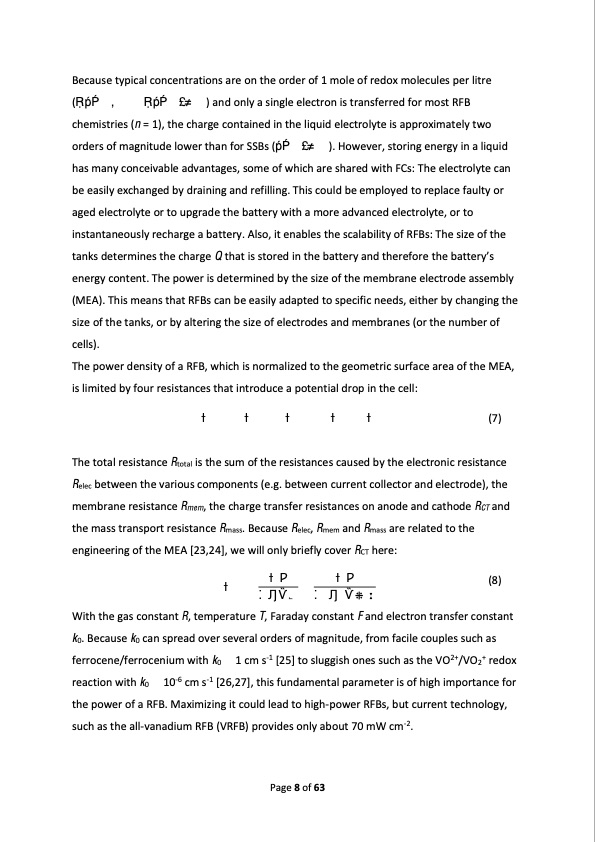
PDF Publication Title:
Text from PDF Page: 008
Because typical concentrations are on the order of 1 mole of redox molecules per litre (� �� � � �� �� ) and only a single electron is transferred for most RFB chemistries (n = 1), the charge contained in the liquid electrolyte is approximately two orders of magnitude lower than for SSBs (�� �� ). However, storing energy in a liquid has many conceivable advantages, some of which are shared with FCs: The electrolyte can be easily exchanged by draining and refilling. This could be employed to replace faulty or aged electrolyte or to upgrade the battery with a more advanced electrolyte, or to instantaneously recharge a battery. Also, it enables the scalability of RFBs: The size of the tanks determines the charge Q that is stored in the battery and therefore the battery�� energy content. The power is determined by the size of the membrane electrode assembly (MEA). This means that RFBs can be easily adapted to specific needs, either by changing the size of the tanks, or by altering the size of electrodes and membranes (or the number of cells). The power density of a RFB, which is normalized to the geometric surface area of the MEA, is limited by four resistances that introduce a potential drop in the cell: ����� (7) The total resistance Rtotal is the sum of the resistances caused by the electronic resistance Relec between the various components (e.g. between current collector and electrode), the membrane resistance Rmem, the charge transfer resistances on anode and cathode RCT and the mass transport resistance Rmass. Because Relec, Rmem and Rmass are related to the engineering of the MEA [23,24], we will only briefly cover RCT here: � �� �� ���� ����� (8) With the gas constant R, temperature T, Faraday constant F and electron transfer constant k0. Because k0 can spread over several orders of magnitude, from facile couples such as ferrocene/ferrocenium with k0 1 cm s-1 [25] to sluggish ones such as the VO2+/VO2+ redox reaction with k0 10-6 cm s-1 [26,27], this fundamental parameter is of high importance for the power of a RFB. Maximizing it could lead to high-power RFBs, but current technology, such as the all-vanadium RFB (VRFB) provides only about 70 mW cm-2. Page 8 of 63PDF Image | Redox Flow Batteries Concepts Chemistries

PDF Search Title:
Redox Flow Batteries Concepts ChemistriesOriginal File Name Searched:
5870EAF5-2D70-44C8-A0A7-62D3A1462269.pdfDIY PDF Search: Google It | Yahoo | Bing
Salgenx Redox Flow Battery Technology: Salt water flow battery technology with low cost and great energy density that can be used for power storage and thermal storage. Let us de-risk your production using our license. Our aqueous flow battery is less cost than Tesla Megapack and available faster. Redox flow battery. No membrane needed like with Vanadium, or Bromine. Salgenx flow battery
| CONTACT TEL: 608-238-6001 Email: greg@salgenx.com | RSS | AMP |